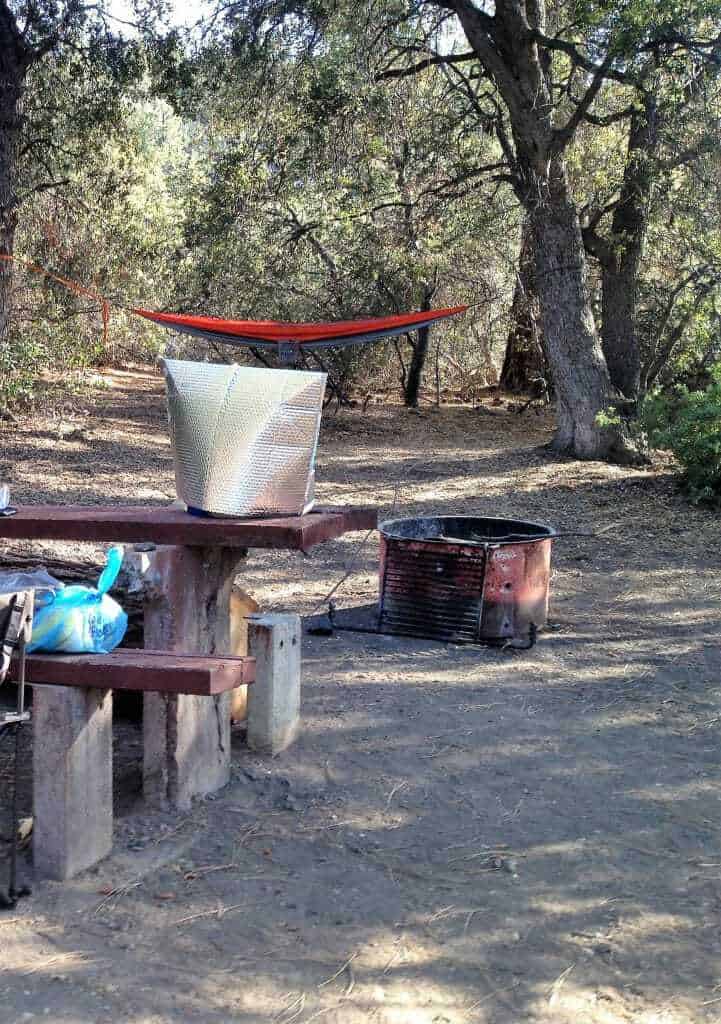There are many reasons why you may not have a kitchen when you are living on the road. It could be due to having a minimalist lifestyle, living basic with van life, or maybe you have a kitchen that doesn’t work in your RV. Whatever the reasoning there are other options. Here I will provide tips on how to cook without a kitchen when on the road.
A fuel canister and mini stove provides you with an alternative option to having a kitchen on the road. Tin foil can be used for a wind guard.
Break Out That Fuel Canister And Stove
A fuel canister and stove is a great choice for those of you on the road that want hot food. This is a very basic option. It can be very affordable depending on how much you want to cook. Here are some other items that go well with this option:
- Tin foil
- Cooking pot– The Sea To Summit brand is great for your on the road needs.
- Long spoon-This Sea To Summit spoon will help get into those hard to reach spots in containers or aid in cooking.
- Bowl/spork-Both of these Sea To Summit items are compact and work well with RV/Van Life.
- Lighter
- Fuel Canister-Never had a problem with this Coleman fuel canister. Very easy to use.
- Mini Stove-The MSR PocketRocket is compact and a good addition to your kitchen on the go.
You might be asking why tin foil? Well you need a wind guard for the flame to heat up your food. This especially goes for boondocking in the Southwest or the Great Plains. Those windy areas will make you reignite that flame over and over if you don’t have a wind guard.
The assembly is pretty easy:
- Put the fuel canister on a flat, stable surface.
- Attach the mini stove to your fuel canister by screwing it on. Make sure the switch is all the way off. You don’t want to have fuel released into the air before taking your lighter to it.
- Take your lighter to the top of the stove, light it and twist the switch so that the stove turns on. I prefer to light it before I switch it on but you can do it afterwards as well.
- Once you got a flame, put your cooking pot on the stove. Wrap your wind guard around the entire stove and fuel canister.
Cook whatever your heart desires. Whether that be a hot drink, boiling water for rice or couscous, the options are endless. If you have room for a pan then you can make stir fry, pancakes, etc. For more ideas on healthy food and fitness on the road, check out this article.
This option has worked for me a lot, especially for that hot drink in the morning. That being said, it’s not the only one I have used.
Using reflectix is a simple and cheap way to cook your food without a kitchen.
No Fuel Canister And Stove? Go Solar!
If you don’t have a kitchen and don’t want to cook with a mini stove, solar cooking is another way to go. You could get a solar oven that’s already made. If you are like me who seeks out more affordable and simple ideas, read on.
To be honest, a piece of reflectix has worked wonders for me when at campsites or boondocking. It does involve more work and certain weather conditions can prevent you from solar cooking altogether. That’s not a reason to shy away from this alternative. Let’s get you started off with a list of items for this no kitchen option:
- A piece of reflectix-This item is basic, simple and to the point. No instructions needed for solar.
- Water Bottle-The Nalgene water bottle is BPA free and very sturdy.
- Bowl/Spork
You definitely want to get this process started early when you get up in the morning. Simply lay your piece of reflectix out in the sun and put whatever you need heated up on it. That may be canned food or a bottle of water. You may need to move the reflectix according to where the sun is shining.
Always make sure you don’t put any dairy or other perishables that may make you sick. Some foods exposed in the sun for that long may spoil.
When your food is hot, get to preparing and eating. If you set out bottled water, then get to hydrating your food. You can put your bowl with the lid on it back in the sun on the reflectix. This helps keep it warm while it hydrates.
When cooking with solar on the road, keep a close eye on critters that may want your food as well.
Here are some other tips and tricks when it comes to solar cooking:
- Bend part of the reflectix to face your food to maximize the heat from the sun. Using a rock helps to keep it bent.
- You may run into some windy weather so put something heavy on the reflectix along with the food. Again rocks come in handy.
Keep an eye on your food if you are parked where there’s more of a nature feel around. Animals and bugs may see your lunch or dinner as a sign of donation for them.
Another note worth mentioning is certain areas may not be as accommodating to solar cooking. Places like the Midwest or Northeast that have a lot of rain, unpredictable weather or winter season may not provide you with much of a solar option. Whereas the Southwest can be perfect for solar cooking.
When done responsibly, fires can be an alternative way to cook your food without a kitchen.
Cook With Fire At Campsites
There are many methods when starting a fire and handling it. I prefer the Tepee fire arrangement. Basically you:
- Stack your wood in the style of a tepee.
- Put your tinder in the middle at the bottom of your wooden tepee.
- Then light the tinder with a lighter.
- Add wood as you go.
Having a grate over the fire is handy to put your pot on. You may not want your pot to get burnt or have a bunch of soot around it. Let your fire takes its course until it’s a bunch of hot coals to prevent this.
Basic materials you will need for a Firepit Kitchen:
- Lighter
- Wood
- Cooking Pot
- Bowl/Spork
- Long spoon
- Mini Shovel-This Black and Decker garden shovel is small and strong to handle camp chores.
- Water
- Tinder-We use dryer lint for tinder, but there are many cheap or free options out there.
Personally, I prefer not using campfires to cook on the road. Only once in a blue moon and under certain conditions I will. Here are some main reasons why:
- It can be dangerous especially during dry and windy conditions
- The smoke can go into neighboring sites and disrupt others
- You have to buy wood.
- Fires makes everything stink afterwards
- It destroys the ground and makes campsites look unattractive
Always keep a lookout for High Fire Warnings in the area you are traveling to.
If you want to still give this no kitchen option a go, here are some tips to do so safely:
- Check the High Fire Warnings in the area you will be in. These are very common in areas in the western part of the United States. This is due to high wind and dryness that occurs in that area. If there is one, don’t mess with having a fire. If you see someone with a fire, report it.
- If there isn’t a Fire Warning but it’s still windy, use a different no kitchen method.
- Make sure there is no debris that will easily burn around your firepit.
- Keep in mind other people who are camping around you. If you are very close to your neighbors, then maybe hold off on having a fire.
- Don’t consume alcohol when handling your fire.
- Always make sure that your fire is completely out when you are done. Saturate the pit with water. Bury it as well to keep lit ashes from flowing away and causing a fire.
- If you are boondocking, destroy your firepit to keep others from using it. I have seen literally 5 or more fire pits surrounding the original at one campsite after revisiting it a year later.
Using the dash in your Camper Van or RV is a great way to heat up food when on the road.
On The Road And Need To Cook? No Problem.
If you are like me then you love saving money especially when it comes to eating on the road. Eating out at restaurants or buying prepared food can get pricey. So here are some tips when it comes to those long road trips:
- When you are at a rest stop, break out that fuel canister and mini stove. It’s a mini kitchen on the go when you need to cook.
- Put your food or a bottle of water up on the dash. The windshield provides a great solar option when driving.
Eating food without a kitchen can have benefits such as saving money and space.
Go Minimal And Eat Cold
Now this isn’t a cooking option but it is an eating option. If you can learn to enjoy eating cold food then go for it. Here are some benefits to going cold turkey, pun intended, when eating without any kitchen choices:
- It saves money on repetitive supplies like fuel canisters.
- It’s great if you are going the minimalist approach.
- It saves space in your RV/Camper Van.
- You have less dishes to wash since you are not cooking with any.
There you go. Now you know how to cook without a kitchen when you are on the road. These cooking options are affordable, minimal, and are very versatile. So get out there and cook without a kitchen.






